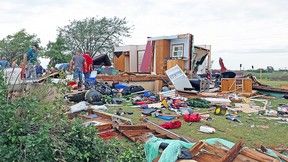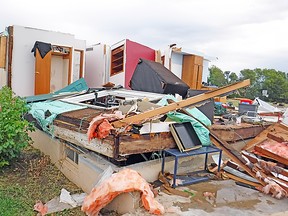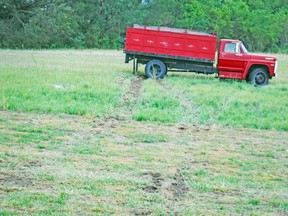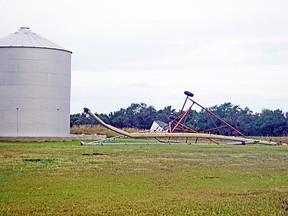
"We were lucky. We were very, very lucky," Bartley said, recalling how his family's home was destroyed Monday night by what the National Weather Service in Topeka is calling "multiple microbursts."
Travis and his wife, Kim, and sons Easton, 6, and Jake, 3, were at home around 8 p.m. in the 1700 block of Eden Road, southwest of Abilene, enjoying a quiet Labor Day evening.
Bartley said he was in the living room on the couch, while his wife and sons were in the back bedroom.
"I was watching TV as the power was flickering on and off," Travis said. "We have a little tree about 20 feet off from the house. I stood up and couldn't see that tree, which I thought was kind of strange. Then the glass in the window broke."

"My oldest (Easton) peeked into the living room just as the built-in bookcase hit me in the back and shoved me down the hallway," Travis said.
Hearing the window break, Kim and Jake came out of the bathroom and "I dropped down on all three of them," Travis said.
With no time to get to the basement, the family rode out the storm in the hallway and eventually were able to take cover under a coffee table, Travis said.
Sometime during the ordeal, the roof was ripped off. When it was finally over, the living room, kitchen, bathroom and much of the house had disappeared.
"There was about 20 to 30 seconds where I wasn't sure we were going to walk away from this," he said.
Afterwards, Travis called 9-1-1 and walked out through what used to be the front door.
The Bartleys then began waiting for emergency responders, who couldn't reach the family due to downed power lines and flooded ditches.
"We spent I guess an hour waiting for emergency crews to get to us. They were trying to get in from every direction," Travis explained. "Finally, a couple sheriff's deputies were able to walk in and check on us."
Easton sustained a deep cut on the eyebrow and ended up with three stitches in his knee and a cut to a toe that was glued.
Travis said he plays the scene over and over in his head and wonders what would have happened if Kim and the boys hadn't left the bedroom when they did or if he hadn't looked outside.
"It all happened in just seconds," he said.
The Bartleys also lost a hog shed and pole barn in the storm.

Although Dickinson County EMS, sheriff's deputies and other first responders headed out immediately after receiving the 9-1-1 call, they were unable to reach the scene due to downed power lines.
Dickinson County Emergency Management Director Chancy Smith was one of the people trying to find a way to reach the Bartleys.
"There was a mile of downed power lines in the road both ways. I was trying to drive around from the other direction and it was impassable because of the mud and power lines in the road also," Smith said, explaining that being unable to reach a scene rarely happens.
"The ditches were flooded so we couldn't drive through any of them. Going by foot was the only way in," he said.
Two proactive sheriff's deputies decided to hoof it in, heading a mile across a field to check on the family and assess the damage.
Then a DS&O lineman and a firefighter with a side-by-side four-wheeler headed out to get the family. The lineman lifted the hot power lines up so the vehicle could drive under them.
"Every pole they got to, they had to lift the power lines up so they could drive under them all the way to the house," Smith said. "Once they got to the house, they loaded the family in the four-wheeler and drove them out, lifting the lines back over them to get them up to the ambulance."
Smith gets emotional when he recalls the ordeal the family went through.
"Kim (Bartley) said it was like an explosion," Smith said. "She's trying to come out of the bathroom with her son and boom, all she can see is rain and the roof is gone off the house. Then they're crawling for their lives to get under shelter because stuff is crashing and walls are flying over them.
"To hear her tell the story is almost too much to listen to," he added. "And then we get out there, but can't reach them."

Although the Bartleys suffered the worst damage by far, they weren't the only residents in that part of the county affected by Monday's storm.
Smith said Vince Berland, who has a horse farm at Flag Road and 1700 Avenue, lost a 60x100-foot hay shed which was sucked out of the ground and thrown into a field.
Four or five little horse barns were destroyed and "blew out into the middle of Flag Road."
Steve Lang, who lives about a mile south on Flag Road, had a grain bin "do a loop-de-loop," Smith said, explaining it blew over, then blew across the road, did a U-turn and blew back into a field about one-quarter of a mile away.
A third area, located at a bridge on Eden Road and 1700 Avenue, sustained enough tree damage that it almost blocked off 1700 Avenue "with trees in the road," Smith said.
"There was a lot of strong winds," Smith said.
Although the destroyed Bartley home looks like something a tornado would do, the National Weather Service in Topeka determined the damage in that portion of the county was caused by a unique phenomena known as "multiple microbursts."
Smith explained a tornado would have left a damage path. In this case however, there were four isolated locations that each received serious damage.
"These were four isolated spots all about a mile or more away from each other. There was no correlation between them and there was stuff in between the spots that was untouched," Smith said. "You could draw a square from each damage location and they would all be in a corner.
"There's no way a tornado would make a path like that," he explained. "Two could make a path, but four altogether? There's no way."
Smith said it looked like a downdraft hit at each location. "It hit east of this spot, so everything blew west; then this downdraft hit west of this other area and blew everything back east," he explained. "It was a unique occurrence.
"It looked like this storm was just firing microbursts at the ground around this area," he said.
When the storm hit Dickinson County around 8 p.m. Monday, no warnings or watches had been issued. While the sky looked menacing with low-lying clouds rotating, Smith said there was no upper level rotation — a necessary component for tornadoes to develop.
"It didn't exist, so the weather service felt confident we weren't going to have a tornado, but they're not talking about microbursts," Smith said. "They're estimating 110 mile an hour winds hit that (Bartleys') house."
NWS officials were on scene Tuesday with Smith conducting a damage survey and "trying to get a read" on what happened, Smith said.
Since multiple microbursts are unusual, Smith said this situation may provide enough information for the National Weather Service to start making warnings for these types of storms.
"They (NWS) want to do something about this," Smith said.
After Smith notified the NWS about the damage in Dickinson County, the NWS did issue a severe thunderstorm warning for Dickinson, Geary and other counties in the path of the storm.
"It was like adding insult to injury to put on the severe weather warning after the storm when through," Smith said. "But they (NWS) were worried about this storm continuing to fire off those microbursts as it continued on its track. They had to set it off to take care of anything on down the line."
Smith said he was going to gather his damage photos, maps and other information and send it to the weather service.
"Hopefully, they'll come up with something so we can let people know what happened, why it happened and what's going to happen differently the next time," Smith said.
Family OK
As for the Bartleys, Travis said they are staying with his parents, Rick and Rhonda Bartley, who live nearby.
Although all the exterior walls of their home were destroyed and the family lost nearly everything, the storm left most of the family's clothes, which they were able to salvage.
"We saved what we could save, but none of it matters," Travis said. "The boys are doing really good. They know their house is gone, but it's something we got through.
"Everybody ended up fine."
What is a microburst?
According to the National Weather Service website, a microburst is a downdraft or sinking air in a thunderstorm that is less than 2.5 miles in scale.
Some microbursts can pose a threat to life and property, but all microbursts pose a significant threat to aviation. Although microbursts are not as widely recognized as tornadoes, they can cause comparable and, in some cases, worse damage than some tornadoes produce. In fact, wind speeds as high as 150 mph are possible in extreme microburst cases.



Reader Comments